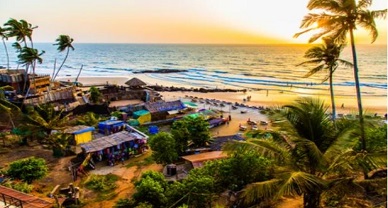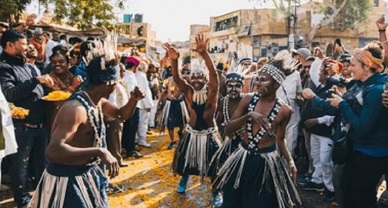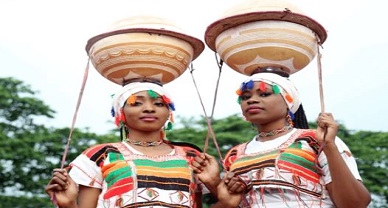Tribes of Goa in the Phase of Conversion
HISTORY OF GOA
After the River Saraswati started drying up, a large group of Saraswat Brahmins through a sea route came to settle at Goa. The migration got increased when the river got completely dried up. Prior to, that the “Skanda Purana” also mentions Goa as the sixth incarnation of Shri Vishnu, Lord Parashuram, who shot an arrow from the top of the Western Ghats into the sea. Where the arrow fell into the sea, he claimed it as his kingdom and directed the sea to withdraw itself. The place today is known as Benali (which means “where the arrow landed”) or Benaulim (a misspelled pronunciation of the word). Benaulim is currently a village located in Goa at the banks of Ocean.[i]
Further, in the early era, Goa was an intrinsic part of the Ashokan Empire. After that, various Hindu dynasties ruled Goa for the next 700 years approximately. The Kadambas came to power with the assistance of the Chalukyas and subsequently named their capital Govapuri on the banks of the Zuari river. In ancient times, the Goa was known as Gove, Gowapura, and various other names relating to the Sanskrit word ‘Gomantak,’ which has various meanings, but the most accepted one is ‘a fertile land.’ After the decline of Chalukyas, the Goa fallen vulnerable to Islamic invasions. The Islamic invasion led to complete destruction, including the destruction of demographics, culture, traditions, and literature. The invaders, driven by fanatic zeal, destroyed temples and various other institutions, murdered priests, and systematically looted their wealth. Many deities got moved to safer areas, only one survives to this very day – the Shree Mahadev Temple at Tambdi Surla.[ii]
Further, the first time Vasco da Gama, a Portuguese explorer, landed in Calicut in 1948, in Kerala. The wealth of India gave an impetus to the Portuguese to establish trade relations with India and earn profits and plunder its wealth by establishing trading posts. It started the Portuguese colonization of India. Gradually, these Portuguese also conquered Goa from Islamic invaders by 1510. Goa became the jewel of the Portuguese empire. The Portuguese were tolerant towards Hindus of Goa, but towards Muslims, they were intolerant. They massacred the Muslim population of Goa in various instances. However, the tolerance policy of the Portuguese was reversed in 1940, after the arrival of St. Francis Xavier and the Jesuits of Goa.[iii]
Thus, from here started the phase of conversion in Goa. An intrinsic state of India, which found its roots in Hindu philosophy as well as the place where Hindus only used to reside, however, as per Census 2011, it has a 66.08 percent population of Hindus only and 25.10 percent population of Christians.[iv] Goa serves as a home for various tribal communities, including four major tribes – Gowdas, Kunbis, Velips, and Dhangars.[v] The article attempts to elucidate the rich history and culture of these prominent tribes and further states how these tribes dealt with the evangelizing campaigns of the Portuguese. However, evangelizing campaigns still exist in India. The article also attempts to put forth the current scenario of such campaigns and concludes with what should be the way ahead to deal with the issues and challenges faced by these tribal groups.
KUNBI TRIBAL GROUPS IN GOA
As referenced above, there are four significant tribal groups in Goa. Notwithstanding, Velips and Dhangars are considered as two areas of ancestral networks under the Kunbis. Kunbis are of Indian starting points that principally have a place with the Nāgpur, Chānda, Bhandāra, Wardha, Nimār and Betūl Districts of the Central Provinces. Kunbis has different types of their names, they are known as Kunbi or Kulambi in the Deccan, Kulwādi in the South Konkan, Kanbi in Gujarāt, and Kulbi in Belgaum. Notwithstanding, in Sanskrit engravings, it is given as Kutumbika (which means householder), and subsequently it has been gotten from ‘kutumba,’ a family. A chronicled case of the 11th century cited by Forbes discusses the Kutumbiks as the cultivators of the grāms living in small villages. Another author depicting the early Rājpūt lines says: “The villagers were Koutombiks (householders) or husbandmen (Karshuks); the village headmen were Putkeels (patels).” Such cases elucidate that Kunbis are the residents of Goa for a very long time.[vi]
Kunbis customs incorporate generally Hindu practices, for example, one can’t wed in his/her family, customs after birth and demise of an individual, and different others. Hindu Kunbis primarily worship Maruti or Hanuman, Shiv or Mahadeo, Devi, Satwai, and Khandoba, which is a manifestation of Shiva. Māroti is revered generally on Saturdays, so he may balance the detestable impacts practiced by the Shani on that day. At the point when another village is established, Māroti should initially be brought and put in the village and revered, and after that houses are constructed. They offer forfeits like goats, fowls, pigs, and wooden pictures of people to Devi. Kunbis also believe in good and evil spirits to a greater extent as their one proverb that stated it aptly is Brāhmans die of indigestion, Sunārs from bile, and Kunbis from ghosts.[vii]
Dhangars is another community, which is considered as a sub-caste under Kunbis of Goa. Dhangars are believed to have migrated to Goa from Gujarat. Members of this tribe are quite pious and religiously worship their god named ‘Bira Deva.’ These tribals are fundamentally shepherds or cattle herders and live a semi-nomadic lifestyle. Their dressing is proof of this, just like the way that they carry a stick at all times and are usually accompanied by one or two hunter dogs.[viii] This clan is confronting an existential danger, yet, it is viewed as neither a Scheduled Tribe nor a Scheduled Caste in India.[ix] This specific local area of tribals rehearses polygamy, with ladies being bought regularly in return for money or kind.

Accordingly, these are a couple of customs and traditions followed by Kunbis and their sub-standings living in Goa. Noticeably they follow Hinduism in any case, because of Portuguese impact, they get changed over to Christianity as well as Islam because of various invasions. The tribals additionally get ruthlessly executed and slaughtered in the past in light of which they likewise lost a huge populace of their local area. Dhangars the sub-caste is facing existential threat just because of some of these reasons.[x]
CONVERSION PHASE AND TRIBAL COMMUNITIES
Dhangars are considered a sub-caste of the Kunbi tribe. They profess Hinduism. According to them, Lord Krishna is their chief god. They believe that their community’s name – Dhangar, is derived from the name of the cow – dhenu, which is Lord Krishna’s favorite animal. Besides this, they worship Shiva, Vithoba of Pandharpur, and also their clan deities such as Khandoba, Shani, Janai, and so on. They must worship their clan deity, especially at the time of birth and marriage ceremonies. They observe important Hindu festivals such as Dussehra, Diwali, and Holi.[xi]
Dhangars face existential dangers because of conversions and massacres previously. Further, the administrations after freedom were additionally not ready to give them SC or ST status to secure them and their way of life. Addressing the Press Trust of India, individuals from the local area claimed that the centre had neglected to follow up on the ST status request raised by the community. The typographical error occurred in states like Bihar, Uttar Pradesh, Odisha, and Maharashtra.[xii] In any case, Bihar and Odisha redressed it. The previous government had disclosed to them that the ‘Dhangar’ people group existed in Maharashtra, however no records about the presence of the said ‘Dhangar’ people group were found with revenue or caste verification departments of the state government, explained one of the members. “The tribal department misguided us, claiming that there are 43,000 people from the Dhangar community, as per the 2011 Census,” as cited in the report by the Press Trust of India report.[xiii]
After the conquest of Goa by the Portuguese, Hindus were converted to Roman Catholicism at a mass scale. This also affected the tribal population of Goa as they also fell prey to the Portuguese missionaries. Nearly 25% of the population of Goa constitute Roman Catholics today. Kunbis being a prominent tribe of Goa, also got affected by these campaigns. The religion of the tribal communities got changed, but they even after that adhere to the customs and traditions of Hinduism. They made their caste system after converting to Christianity. The Brahmins as Bamonns Kshatriyas as Chardos, Vaishyas as Gauddos, and Shudras as Sudirs. However, more or less, the conversions led to the destruction of their culture and traditions as they started aspiring for the Western culture. Thus, conversion affected the communities in an adverse manner.
CONCLUSION
History cannot be revamped, but we can learn from our past to make the future better. Dhangars being one of the most prominent tribal communities of Goa, is suffering from an existential threat. The government data state false figures as they are already becoming extinct from various states while it shows that they still reside there. It is high time government should take steps to protect these communities by listing them in the list of Scheduled Tribes so that they can enjoy the privileges and protect themselves. The government must keep a check on evangelizing campaigns and make the citizens aware through various campaigns and workshops so that they can realize what legal resorts are available to them if they ever get subjected to forced evangelization. Thus, there is a need from the side of the government to come forward and ponder over the issues so that the tribal communities who are already ostracized and ignorant of the outside world might also enjoy their rights.
Author:- Kaustubh Kumar, in case of any queries please contact/write back to us at support@ipandlegalfilings.com or IP & Legal Filing.
REFERENCES
[i] Brief History of Goa, Goa Chambers of Commerce and Industry, Available at: http://www.goachamber.org/item/brief-history-of-goa/ (Last Visited on May 19, 2021).
[ii] Id.
[iii] Robinson, Rowena, Some Neglected Aspects of The Conversion of Goa: A Socio-Historical Perspective, Sociological Bulletin, vol. 42, no. 1/2, pp. 65–83, Jstor, www.jstor.org/stable/23620248 (1993).
[iv] The Goa Religion Census 2011, Government of India.
[v] ItsGoa, What do you know about the tribes of Goa and their backgrounds?, ItsGoa (February 15, 2018) https://itsgoa.com/tribes-goa/
[vi] R.V. Russell, Rai Bahadur Hira Lal, The Tribes and Castes of the Central Provinces of India, Vol. IV, Macmillan and Co., Limited St. Martin’s Street, London (1916), Available at: https://www.gutenberg.org/files/20668/20668-h/20668-h.htm (Last Visited on May 19, 2021).
[vii] Id.
[viii] Ibid. at 5
[ix] Four Generations on, Dhangars still fight for ST status, The Times of India (January 29, 2020, 01:14 PM), https://timesofindia.indiatimes.com/city/goa/four-generations-on-dhangars-still-fight-for-st-status/articleshow/73726385.cms
[x] Suryasarathi Bhattacharya, Kalyan Varma’s documentation of the Dhangars reveals existential threat facing pastoral tribe, Firstpost (February 28, 2020, 09:12 AM), https://www.firstpost.com/long-reads/kalyan-varmas-documentation-of-the-dhangars-reveals-existential-threat-facing-the-pastoral-tribe-7707161.html
[xi] K.S. Singh, P.P. Shirodkar, H.K. Mandal, Dhangar, Anthropological Survey of India, Popular Prakashan Pvt. Ltd. (1993), Available at: https://blog.parrikar.com/wp-content/uploads/2012/04/dhangars.pdf (Last Visited on May 19, 2021).
[xii] Ibid. at 13.
[xiii] ‘Dhangar’ community raises pitch for ST status, The Press Trust of India (May 19, 2021 07:26 PM), http://www.ptinews.com/news/9928239_-Dhangar–community-raises-pitch-for-ST-status.html


